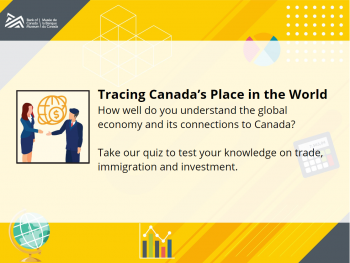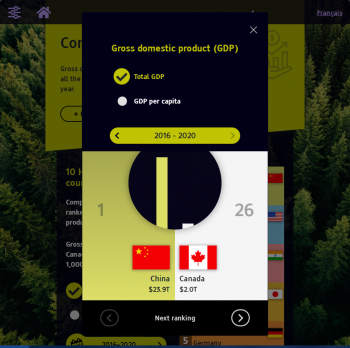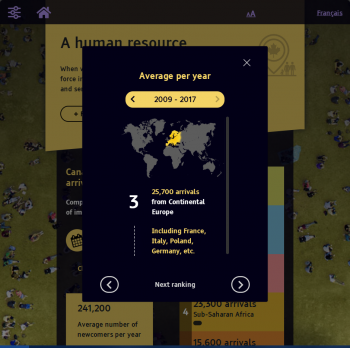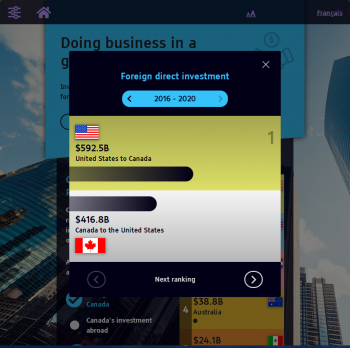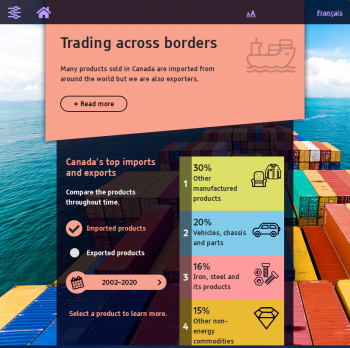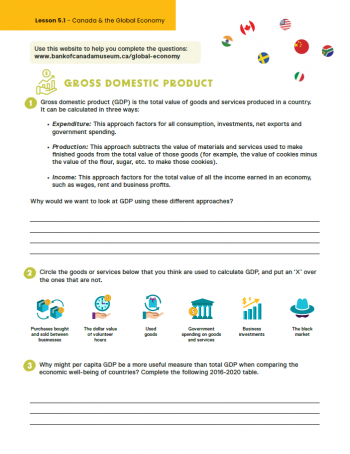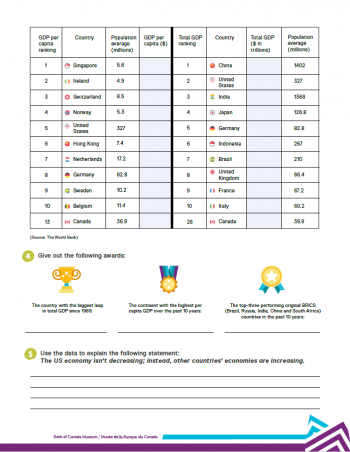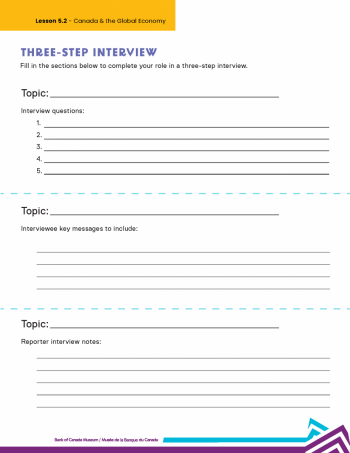
Use a data visualization tool to learn about how Canada’s place in the global economy has evolved.
Overview
Part of the “You Are the Economy” series of lessons, this lesson plan introduces the Canadian economy and where it fits in the global economy. For best results, follow the activities in order.
Big idea
Looking at Canada through a global lens helps us understand its connections to the world economy.
Total time
100 minutes (plus optional homework time)
Grade levels
Grades 7–12; Secondary I–V
Subject areas
Social studies
- Canadian economic development since Confederation
- the role global events play in Canadian immigration and our economy
- the impact of globalization on markets
- regional and international economic development
- history of immigration in Canada
Economics
- gross domestic product (GDP)
- economic globalization
- information analysis using economic thinking
- social, cultural and economic consequences of growth and development
Learning objectives
Students will:
- analyze global economic data on GDP, immigration, investment and trade
- compare economic indicators at different periods from Confederation to today
- discuss an economic issue from different perspectives
Materials
Classroom supplies and technology
- pens or pencils
- smartboard, or projector and screen
- internet-connected devices (phones, tablets or computers)
- internet connectivity
Handouts and worksheets
- Download the lesson plan, worksheets and answer key.
- Print these resources:
- “Canada and the global economy” worksheet—one copy per student
- “Three-step interview template”—one set per group of three students, printed single-sided on regular paper (optional)
- Access and display these online resources to review together:
- “Tracing Canada’s place in the world” online quiz
- "How does Canada fit into the global economy?" data visualization tool
For greener options, you can ask students to:
- use an internet-connected device to fill in fields on the PDFs of the worksheets
- use their notebook to write the questions, key points and interview notes for their three-step interviews
Activity 1: Check background knowledge
Start with an online quiz to review what students know about Canada’s connection to global markets and how aspects of its economy have changed over time.
Time
10 minutes
1.1 Conduct the quiz
Explain to your students that they will be looking at four different topics that connect Canada to the wider global economy: gross domestic product, immigration, foreign investment and trade.
Tell your students that they will start with an online quiz to see how much they already know about Canada’s role in the wider global economy and how this has changed over time. Explain that the quiz consists of 12 multiple-choice questions on the Canadian economy, and students will receive a score at the end.
Open the quiz on a web browser and display it on a smartboard or screen. Complete it as a whole class. Alternatively, ask students to take the quiz individually on their internet-connected device.
The quiz consists of 12 multiple-choice questions on the Canadian economy.
1.2 Check for understanding
Upon completion, ask your students to share questions they found challenging. Together, review the concepts and possible answers.
You may want to assess your students by having them take the quiz individually at both the beginning and the end of class—then compare their scores.
Activity 2: Explore how Canada fits into the global economy
Use the data visualization tool and student package to analyze Canada’s trends and trajectories within the global economy.
Time
40 minutes
2.1 Navigate the data visualization tool
Open the tool “How does Canada fit into the global economy?” on a web browser, and display it on a smartboard or screen.
The tool’s layout may differ slightly depending on the screen or device used. Click on the icon at the top left of the page to customize your experience. Here, you can turn on or off the animations as well as choose the OpenDyslexic font to help students with dyslexia better distinguish words and letters.
First, as a class, review the features of each of the four topics: gross domestic product, immigration, foreign direct investment and trade.
Take a moment to show students the “+ Read more” button at the top of each topic so that they can expand the introduction text.
Each topic includes an option to change the timeline or date range of the data. Click on the calendar icon, select a date range from the list, and click “Apply.”
You can click on each of the facts listed in the coloured bars to expand for more information:
Before the next task, you may want to check your students’ ability to use the tool.
Have them open the tool in a browser on their device. If they are using a tablet or computer, they can switch between topics by clicking on the home button on the top left of the screen. If using their phone, they can scroll down to the bottom of the page for buttons accessing other topics.
Ask them the following questions, giving them 30 seconds after each question to search the tool for the answer. Then have them respond by holding up the correct number of fingers.
- In the most recent timeline data of the GDP topic, where does Belgium rank in GDP per capita? (Answer: 10th place)
- In the earliest immigration data from 1867–95, where was Asia ranked as the origin region of newcomers to Canada? (Answer: 4th place)
- In the foreign direct investment data, how many countries both invested in and received investment from Canada in 2016–20? (Answer: three countries—the United States, the United Kingdom and the Netherlands)
- In the trade data, where is agriculture ranked in imported products in 1867–1914? (Answer: 2nd place)
2.2 Use the tool to answer some questions
Next, have your students use the data visualization tool to answer the questions in the student package. Give each student a copy of the “Canada and the global economy” worksheet, if using paper, or ask them to open the PDF of this worksheet on their device.
Students explore each of the data tool’s four connected topics using the worksheet.
Students can complete the worksheet as a class, in four smaller groups or individually. Ask them to fill in their answers on either the printed or the PDF version of the worksheet, working through the four topics. Check in after each of the sections.
If time is limited, have the class do the first topic, GDP, and assign the rest for homework. Or if they are working in groups, you may wish to conduct this task as a jigsaw activity, with each group working on one of the four topics and then students sharing information between groups.
Some of the questions require a deep dive into the data found in the tool, while others are broader questions. If your students find any questions challenging, you could let them to do further online research to help construct their answers.
Use the answer key to check for comprehension and to help students needing more support to find the answers.
2.3 Review global economic concepts
Come back together as a class and review some of the ideas discussed in the tool and student package.
Ask your students to share some things they noticed while exploring the data tool. What factors make Canada a significant player in the global economy? Review the following information as part of your discussion:
- Canada has a wealth of natural resources; a strong, internationally linked manufacturing sector; and a growing service industry. These primary, secondary and tertiary (or services) sectors are supported by geography and relationships with other economic powerhouses.
- Canada has huge reserves of natural resources. It produces and exports natural gas, oil, minerals and wood to trading partners around the world, especially the United States and China.
- Automotive and aerospace manufacturing industries are big Canadian exporters. Technology hubs across the country are also growing.
- Canada is a democracy with a stable financial system. This makes the Canadian dollar a popular currency for foreign reserves and improves when Canadians enter new markets for banking, insurance and other sectors.
- Canada’s proximity to the United States, whose population is nearly 10 times as large as Canada’s, means that most of its trade is with its southern neighbour. But historical ties to European countries and membership in many international organizations, such as the Group of Seven (known as the G7), the G20 and the North Atlantic Treaty Organization (or NATO), also help to support international trade and investment.
The Bank of Canada monitors and gathers data on the global economy to better anticipate external shocks and their potential impact on the Canadian economy. An example of a shock is a disruption to global supply chains. A supply chain disruption could cause a goods shortage and lead to sudden or prolonged price increases. Global monitoring also helps to determine if a foreign country’s economy is operating above or below its capacity.
Activity 3: Interview classmates on economic topics
Have students conduct three-step interviews on economic topics using prompts and perspectives inspired by Dr. Edward de Bono’s book Six Thinking Hats.
Time
40 minutes
3.1 Introduce a thinking concept
Have students think of an issue and the different perspectives they can take on it, such as being an optimist or pessimist. Ask them what other ways can they think about that issue. Answers will vary.
Point out that we can use a range of perspectives to help us consider an issue from different angles. Introduce the de Bono Group’s concept of Six Thinking Hats®. Explain to your students that each hat represents a different way of thinking. Review each of the hat perspectives below. Using these hats can help students better understand a situation and come up with well-rounded solutions.
Blue hat: The conductor's hat
This hat frames the conversation. When you wear the blue hat, you make sure the rules are followed, and you set goals and agendas.
Green hat: The creative hat
This hat is all about creativity and new ideas. When you put on the green hat, you think about alternatives, possibilities and new solutions.
Red hat: The hat for the heart
This hat involves feelings and intuition. When wearing the red hat, you don't need to justify your feelings. You simply express them to understand how emotions affect a situation.
Yellow hat: The optimist's hat
This one sees the positive in every situation. Wearing the yellow hat, you look for benefits. It helps you see the value and the good in situations.
Black hat: The judge's hat
The black hat is cautious and careful. It helps you to see why an idea might not work. This is important for making safe decisions and understanding possible problems.
White hat: The factual hat
This hat is all about facts and information. When you wear this hat, you focus on the data you have, what you need and what you can learn.
Source: Used with permission from debono.com
3.2 Assign roles for the three-step interviews
Next, have students form groups of three to conduct a series of three-step interviews.
Explain that they are called this because each has three different roles with different steps to complete. Each interview has an interviewer, an interviewee and a reporter:
- The interviewer drafts three questions to ask the interviewee, based on a prompt the group chooses.
- The interviewee answers the questions, based on the prompt.
- The reporter takes notes throughout the interview and synthesizes them into a few big ideas or key takeaways.
Have students choose one of the four topics from the data visualization tool for their interview. Then ask each group to take one of the three prompts for that topic from the lists below, or they can suggest one of their own. To encourage them to think widely about a topic, explain that each prompt is phrased as a position or opinion that can be supported or challenged, and each is linked to a thinking hat perspective. (Note, for these interviews, they will not use the blue hat.) Explain that to have a full discussion, the three members of the group need to use the same prompt and thinking hat.
Prompts for gross domestic product
- GDP is only one measure of a country’s well-being. Other measures should also be considered, such as health, safety and sense of community. (white hat)
- Canada’s reliance on natural resources is a strength (or weakness) for GDP growth. (black and yellow hats)
- Canada’s GDP shows a lack of productivity, and this should be dealt with using new solutions. (green hat)
Prompts for immigration
- Immigration is vital to Canada’s future economic and social well-being. (red hat)
- Canada needs to be cautious about the number of immigrants it accepts. (black hat)
- To support economic goals, Canada should have specific criteria for new immigrants. (white hat)
Prompts for foreign direct investment
- Canada wields a lot of power when it invests. It should withhold investment from undemocratic countries to encourage them to change. (red hat)
- Canada should invest in alternative energy industries and sectors to support a green transition. (green hat)
- Foreign investment in Canada leads to job creation and economic growth, outweighing any negative consequences. (white hat)
Prompts for trade
- Canada should import less and return manufacturing to the country to increase “made in Canada” products. (green hat)
- Global supply chains for manufacturing and transporting goods benefit everyone. (red hat)
- Canada needs to be more competitive with its trading partners and in what it trades. (black hat)
Assign interview roles or have the members of each group select a role. Depending on age level and group, you can use this activity to practice communicating from a particular perspective. Ask the students to add a bias to each of their roles, from the interviewer questions to the interviewee’s answers, as well as the reporter’s summary.
3.3 Conduct the interviews
Hand out one copy of the “three-step interview template” to each group of three. Or display the template on a screen and ask students to write their questions and jot notes in their notebook. Review the template together.
Give students in the interviewer role time to formulate their questions on their topic, based on the prompt the group has chosen. Meanwhile, the interviewee can start to outline some key messaging they will want to include in their answers, and the reporter can take a small break.
When the interviewer and interviewee have completed the interview and the reporter has summarized their notes as key takeaways, have the group rotate roles and do the interview again. Remind them to use the same prompt and thinking hat perspective and give the new interviewer some time to create three new questions.
Use the three-step interview template to allow students to jot notes based on their role.
You can extend this activity by giving students time to do some preliminary research to better prepare questions and answers. They can use the data visualization tool and other resources.
Alternatively, you may want to have younger students do only one set of interviews or reduce the number of questions per interview.
Conclusion
Time
10 minutes
End the lesson by doing a four-corners activity to see what students have learned.
Tell your students that you will ask them a question with four possible answers and that each corner of the room represents one answer. Designate a specific answer to each corner of the room. The four answers are:
- GDP
- foreign investment
- immigration
- trade
Ask the students, “What area of the economy did you learn the most about today?” Direct them to move to the corner of the room that best reflects their response.
After they have all moved to a corner, ask some students from each corner to explain why they chose that answer.
For a broader class discussion, close by asking your students why they think it’s important that Canada be a strong player in the global economy.
If time allows, close with the following points:
- Wealth begets wealth—being seen as a strong, stable economy encourages foreign investment, which then creates more local jobs and supports industries of the future.
- Canada’s position as an economic leader helps it manage its foreign affairs, make trade agreements with partners and provide development aid to other countries.
- Historical links to European countries and our diverse population mean that Canada is connected with many countries—more now than ever before.
- A strong and diverse economy helps Canada ride out financial shocks such as global or regional economic downturns or sudden shifts in markets.
Key takeaways
- Canada’s economy is interconnected with a global movement of resources, tradable goods and services, people, and investments.
- Overall, Canada has had a strong place in the global economy since Confederation.
- Sharpening your data literacy skills can help you recognize trends.
Extensions
- Have your students draft research questions after from analyzing the data in the visualization tool. Form these questions into independent or group research projects.
- Explore more country-specific data on debt, GDP and investments using the Place Explorer tool on Google’s Data Commons site.
- Assign students the role of trade representative to or from one of Canada’s top trading or investing partner countries. Have them prepare a pitch for their own government to invest more in Canada. Or have them pitch to the Government of Canada to invest more in their country, based on their research into the industries of that nation. Make sure students are aware of diverse categories such as finance, insurance and natural resources.
- Explore the World Happiness Report and have students compare top- and bottom-ranked countries with their respective rankings of global total and per capita GDP. Compare the lists using a Venn diagram or a longer comparative summary.
- As a class, look into the points-based system for skilled immigrants to Canada and have students review the questions and how the points are assessed. Ask them to think about the effectiveness of this system and whether they have concerns around biases or discrimination. How do refugee or asylum claimants fit within the larger system?
We want to hear from you
Comment or suggestion? Fill out this form.
Questions? Send us an email.
